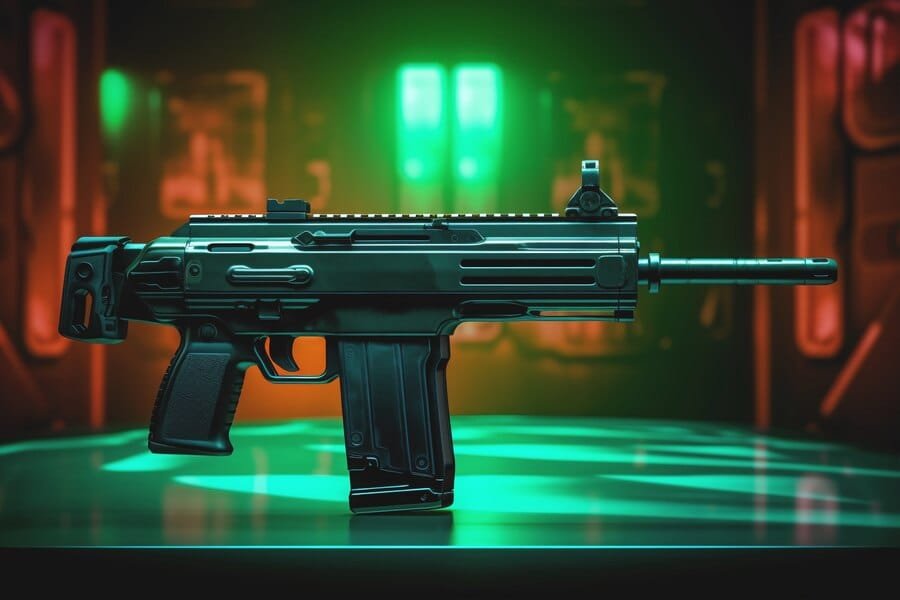TECHNOLOGY
The TEC-9: A History of Innovation, Controversy, and Legacy in Firearms

The TEC-9 is one of the most recognizable submachine guns and semi-automatic pistols in modern firearm history. Developed by the Swedish company Interdynamic AB in the late 1980s, the TEC-9 quickly garnered a reputation for both its innovative design and its controversial use. Known for its distinct look, high capacity, and potential for modification, the TEC-9 has left a significant impact on the firearms world. However, its connection to violent crimes and its subsequent banning in the United States has made it a polarizing symbol in debates about gun control, firearms regulation, and public safety.
In this article, we will explore the history, technical specifications, and cultural impact of the TEC-9. We will also delve into its various iterations, its role in popular media, and the controversies that have surrounded it. Finally, we will consider the TEC-9’s enduring legacy in modern firearms design and public perception.
The Origins of the TEC-9
The story of the TEC-9 begins in Sweden during the early 1980s when Interdynamic AB, a small arms manufacturer, developed the original Interdynamic MP-9 submachine gun. The MP-9 was designed as a compact, high-capacity firearm that could function as both a submachine gun and a semi-automatic pistol. This versatility was intended to appeal to law enforcement and military markets, though the MP-9 never gained significant traction with those users.
In the mid-1980s, a Miami-based company called K.B.I. Inc. began importing the MP-9 into the United States under the name TEC-9. The gun was modified to comply with American firearm laws, specifically changing its fire mode from full-auto to semi-auto. The TEC-9 was marketed as a semi-automatic pistol that could accept large-capacity magazines, often in the range of 32 rounds or more. Its unique design, featuring a large, chunky frame and the signature cone-shaped muzzle, made it instantly recognizable.
The TEC-9 quickly became popular among gun enthusiasts, who appreciated its affordability, high magazine capacity, and the ability to mount a variety of accessories, including scopes and suppressors. However, its appearance, combined with its features, also caught the attention of law enforcement and public safety advocates.
Technical Specifications and Features
The TEC-9 has several features that distinguish it from other firearms of its time. Most notably, the TEC-9 is chambered in 9mm Parabellum, a common caliber used for handguns and submachine guns. This gave it significant stopping power while still being manageable for shooters, even in its large configuration.
Some of the key technical specifications of the TEC-9 include:
- Caliber: 9mm Parabellum
- Action: Blowback operated, semi-automatic
- Barrel Length: 5.5 inches (varies slightly depending on the model)
- Overall Length: 15.5 inches (varies depending on the configuration)
- Weight: Approximately 3.5 pounds (varies with different models)
- Magazine Capacity: Typically 32-round magazines, although larger magazines up to 50 or 72 rounds were available
- Sights: Fixed iron sights, with options for modifications
- Muzzle: A distinctive cone-shaped muzzle brake that helped reduce recoil
The gun’s blowback operation means that the force of the fired cartridge is used to cycle the action, eject the spent casing, and load the next round into the chamber. This simple design makes the TEC-9 relatively easy to produce and maintain, contributing to its low cost compared to other firearms at the time.
Variations and Evolution of the TEC-9
Over the years, the TEC-9 saw several variations and updates. The most notable version was the TEC-9 model, but it was followed by an improved version called the TEC-DC9, which featured a more compact design and a slightly more ergonomic build. The TEC-DC9 was produced for a period before being discontinued, but the model remained a popular choice for gun owners who appreciated its flexibility and potential for modification.
The AB-10, another version of the TEC-9, was introduced with a more compact frame and a different magazine well. The AB-10 was also available in semi-automatic configuration and was aimed at the civilian market, where it found its niche due to its high-capacity magazines.
Finally, the MasterPiece Arms MPA Series, introduced after the original TECs-9 was discontinued, continued the legacy of the TEC-9’s high-capacity, semi-automatic handgun designs. While the MPA series is not directly a TEC-9 product, its design heavily drew from the innovations established by the TEC-9 in terms of aesthetics and performance.
The TEC-9’s Cultural Impact and Media Appearance
The TEC-9’s appearance, with its rugged and industrial design, made it a standout in the world of firearms. Its distinctive look also made it a frequent fixture in media, particularly in action films and television shows throughout the 1980s and 1990s. It became a symbol of power and militancy, often associated with gang violence or criminal enterprises in popular culture.
The TEC-9 made its way into movies such as “Scarface” (1983), where it was used by drug lords and gangsters in high-intensity scenes. The film, which became a cult classic, helped cement the TEC-9’s association with violence and illicit activities. Its frequent appearances in action films and criminal dramas contributed to its negative perception in the public eye.
As a result, the TEC-9 became a weapon of choice for criminal elements and was used in several notorious criminal incidents. Its high magazine capacity, combined with its relatively low price and easy availability on the black market, made it an attractive option for those seeking a weapon for self-defense or criminal activity. This association with violence and criminality would contribute to the TEC-9’s eventual public controversy.
The TEC-9’s Legal Troubles and Banning
Due to its design and capabilities, the TEC-9 quickly attracted the attention of gun control advocates and lawmakers. The 1994 Federal Assault Weapons Ban, which prohibited the sale of certain types of semi-automatic firearms and high-capacity magazines, played a pivotal role in the fate of the TEC-9. Though the TEC-9 was never classified as an “assault weapon” by the federal government, the ban included provisions that severely restricted the sale and production of high-capacity magazines, which the TEC-9 was famous for using.
At the time of the ban, TEC-9s were being used in a number of high-profile criminal incidents, further fueling the push for stricter firearm regulations. In addition, the gun’s notoriety in media and pop culture helped shape public perception of it as a dangerous, criminal weapon.
In 1995, after the Federal Assault Weapons Ban was passed, production of the TECs-9 was effectively halted, and it was removed from circulation in many parts of the United States. However, it should be noted that despite the ban, the TECs-9 continued to be available on the black market and in certain international markets, where it maintained its popularity among gun enthusiasts and criminals alike.
In the aftermath of the ban and the controversies surrounding the TEC-9, its brand name and reputation remained tarnished. The association with criminal violence and its use in multiple high-profile shooting incidents made it a symbol of misuse and misapplication of firearms in the wrong hands.
The TEC-9’s Legacy
Despite being largely phased out of production, the legacy of the TEC-9 continues to be felt in the world of firearms and gun culture. Its reputation remains controversial, as it symbolizes a weapon that is easy to modify and often linked with violent crime. On the other hand, some firearms enthusiasts still admire its design, flexibility, and the sheer capacity of its magazines.
Moreover, the TEC-9’s influence can be seen in the continued development of semi-automatic pistols and submachine guns with similar high-capacity features. Companies like MasterPiece Arms have created models that are akin to the TECs-9 in both design and functionality. The legacy of the TEC-9 can be seen in the evolution of firearms that prioritize versatility and high magazine capacities, even as debates about their regulation continue to rage.
In the end, the TECs-9 stands as a symbol of innovation, controversy, and legacy in the world of firearms. While its popularity has waned over the years, its impact on gun culture and its place in history as both a tool of self-defense and a weapon of crime continues to resonate. Its story highlights the delicate balance between technological innovation and its potential consequences when misused, and it remains a powerful reminder of the complicated relationship between firearms, regulation, and society.
TECHNOLOGY
Vault-Tec: The Iconic Fallout Corporation Behind the Shelters of a Post-Apocalyptic World

n the world of Fallout, the name Vault-Tec is synonymous with the looming shadow of a dystopian future, where humanity has sought refuge in underground shelters from the devastation of nuclear war. Vault-Tec Corporation, though fictional, has become one of the most iconic entities in video game history, its dark legacy intertwined with the creation of the Vaults—bunkers meant to save a select few from the devastation of global nuclear conflict. But Vault-Tec’s history is far more complicated than just the design and construction of these bunkers. It represents a twisted vision of survival, ethics, and experimentation gone awry.
Vault-Tec was ostensibly a humanitarian organization, promising to safeguard humanity and ensure its survival in a post-apocalyptic world.
In the years leading up to the Great War, the Vault-Tec Corporation operated as a large-scale contractor for the U.S. government. Its mission was to create a network of Vaults to house the population in the event of a nuclear conflict. However, the true nature of Vault-Tec’s operations was far more sinister than its public image as a protective entity. As tensions between world powers escalated, Vault-Tec positioned itself as a solution to the impending catastrophe.
For example:
Vault 13:
In Fallout lore, Vault 13 was designed to house 1,000 people. But due to a malfunction in the Vault’s control systems. The inhabitants were left without a water chip for an extended period. The experiment in Vault 13 was not to test the effects of a lack of water but, rather, the company’s ability to make long-term survival decisions based on basic needs.
Vault 101:
The Vault in Fallout 3 is another example of an experiment. The Vault’s inhabitants were confined to the Vault for their entire lives. Isolated from the outside world to test the psychological and social effects of total isolation.
The Vault’s Overseer was instructed to prevent anyone from leaving, even if the outside world was safe.
What Vault-Tec’s leaders failed to consider, however, was the moral and ethical implications of these experiments.
Vault-Tec’s Leadership and Corruption
The corrupt and morally bankrupt leadership of Vault-Tec is a key aspect of its identity in the Fallout series. While Vault-Tec publicly presented itself as a lifesaver for the masses, behind the scenes, its executives were more interested in advancing their own personal agendas.
The U.S. government, grappling with fears of global annihilation, trusted Vault-Tec to oversee the survival of its citizens in the event of a nuclear war. . Rather than fulfilling its contract to protect humanity. Vault-Tec’s executives sought to push forward their own research, often sacrificing human lives in the process. While some Vaults may have begun as legitimate survival shelters, they quickly turned into testing grounds for human psychology and behavioral experimentation.
Fallout: The Fallout of Vault-Tec’s Actions
By the time the bombs fell, Vault-Tec had become an agency of secrecy, greed, and manipulation.
Vault-Tec’s Legacy in the Fallout Series
Vault-Tec has become one of the most recognizable brands in the Fallout universe. Its logo—a stylized vault door—has become synonymous with the series itself. Vault-Tec’s dark legacy provides much of the narrative drive for Fallout, shaping both the tone of the world and the player’s experience as they uncover its hidden secrets.
Vault-Tec in Pop Culture and Legacy
Vault-Tec has transcended the Fallout series, becoming a part of modern pop culture. Its use as a symbol of corporate greed, unchecked government power, and dystopian control has inspired numerous real-world references, from references in other video games to political commentary on government overreach and corporate malfeasance.
It reflects the fundamental moral questions posed by the Fallout series: What are the costs of survival? And ultimately, can we ever truly trust those in power to protect us?
Its dark legacy serves as a cautionary tale of what happens when humanity prioritizes control over compassion.
TECHNOLOGY
Credit Hero Score: A Comprehensive Guide to Understanding and Improving Your Credit Score
Blog
Sheppard Software: Revolutionizing Learning Through Interactive Games and Educational Tools
- FASHION7 years ago
These ’90s fashion trends are making a comeback in 2017
- ENTERTAINMENT7 years ago
The final 6 ‘Game of Thrones’ episodes might feel like a full season
- FASHION7 years ago
According to Dior Couture, this taboo fashion accessory is back
- ENTERTAINMENT7 years ago
The old and New Edition cast comes together to perform
- Sports7 years ago
Phillies’ Aaron Altherr makes mind-boggling barehanded play
- BUSINESS7 years ago
Uber and Lyft are finally available in all of New York State
- ENTERTAINMENT7 years ago
Disney’s live-action Aladdin finally finds its stars
- Sports7 years ago
Steph Curry finally got the contract he deserves from the Warriors






